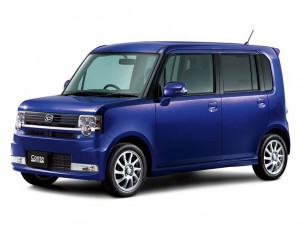The minicar market is apparently a big deal for Toyota Motor Co. The world’s largest maker will begin selling some of the pint-sized products produced by its Daihatsu subsidiary under its own brands.
The news, announced this morning from Japan, appears to be limited to the domestic home market, where 1.22 million minicars were sold during just the first eight months of this year. But with growing interest in such vehicles abroad, particularly in such places as Europe, it remains to be seen whether Toyota will move to expand the distribution arrangement with Daihatsu.
Starting in autumn 2011, Toyota will distribute three minicars through its Corolla and Netz distribution networks. Sales are expected to total about 60,000 vehicles annually.
“The minivehicle market has been expanding lately and more of our customers are asking for them,” explained Toyota Executive Vice President Yoichiro Ichimaru, at a press conference in Tokyo.
The decision to tap Daihatsu for the new models will allow “our focus (to) remain on the non-Mini segment,” the executive added. “But this way we will be able to meet the needs of such customers.”
The move will be particularly good news for Daihatsu, the Japanese minicar segment leader, in which Toyota currently holds a 51% stake. It will help the smaller maker boost volume in a segment with plenty of competition and extremely low profit margins.
The minicar segment has been one of the rare bright spots in the generally moribund Japanese car market, sales rising 8% for the year, through the end of August.
That’s actually off a bit from the rest of the market, reflecting government incentives designed to spur the sale of larger, more expensive automobiles. But where minicars currently account for about a third of overall Japanese sales, industry analysts believe that could eventually climb to as much as half.
The technical definition of a minicar covers vehicles no larger than 11.15 feet in total length, 4.86 feet in width, and 6.56 feet in height. Engine displacement must be less than 600 cc under Japanese law, though the rules vary in other markets.
Demand for the segment has been driven by high fuel costs but also by the increasingly crowded nature of Japanese roads and the limited availability of parking, especially in traffic-snarled cities like Tokyo.
At the Tokyo news conference, Daihatsu President Koichi Ina said Toyota will market a version of the Move Conte passenger car and Hijet commercial vehicle. The partners are still discussing a third model.
The minicar market was once a distinctly Japanese phenomenon, but demand has been growing abroad, a trend Daimler AG has tried to tap with its Smart brand. It remains to be seen whether the segment will continue to grow globally — and whether Toyota would try to tap into it if that happens. The maker has been downsizing around the world and will soon launch an American version of one of its smallest current offerings, the iQ, under the U.S. Scion badge.

